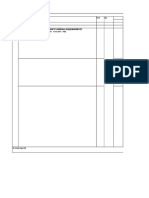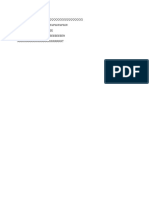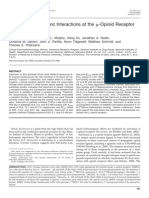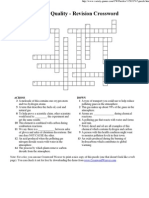0 ratings0% found this document useful (0 votes)
156 viewsMethod Statement For Site Handling of Concrete Made With GGBS
Method Statement For Site Handling of Concrete Made With GGBS
Uploaded by
abobeedoThis document provides guidance on handling concrete that contains Ecocem Ground Granulated Blastfurnace Slag (GGBS) cement. It addresses health and safety considerations, quality assurance testing, pre-ordering arrangements, taking delivery, placing, compacting, finishing, curing, striking formwork, and considerations for cold and warm weather conditions. The document emphasizes that concrete with GGBS has longer setting times, requires adequate curing, and normal precautions should be followed for cold and warm weather work.
Copyright:
© All Rights Reserved
Available Formats
Download as PDF, TXT or read online from Scribd
Method Statement For Site Handling of Concrete Made With GGBS
Method Statement For Site Handling of Concrete Made With GGBS
Uploaded by
abobeedo0 ratings0% found this document useful (0 votes)
156 views2 pagesThis document provides guidance on handling concrete that contains Ecocem Ground Granulated Blastfurnace Slag (GGBS) cement. It addresses health and safety considerations, quality assurance testing, pre-ordering arrangements, taking delivery, placing, compacting, finishing, curing, striking formwork, and considerations for cold and warm weather conditions. The document emphasizes that concrete with GGBS has longer setting times, requires adequate curing, and normal precautions should be followed for cold and warm weather work.
Original Title
Method Statement for Site Handling of Concrete Made With GGBS
Copyright
© © All Rights Reserved
Available Formats
PDF, TXT or read online from Scribd
Share this document
Did you find this document useful?
Is this content inappropriate?
This document provides guidance on handling concrete that contains Ecocem Ground Granulated Blastfurnace Slag (GGBS) cement. It addresses health and safety considerations, quality assurance testing, pre-ordering arrangements, taking delivery, placing, compacting, finishing, curing, striking formwork, and considerations for cold and warm weather conditions. The document emphasizes that concrete with GGBS has longer setting times, requires adequate curing, and normal precautions should be followed for cold and warm weather work.
Copyright:
© All Rights Reserved
Available Formats
Download as PDF, TXT or read online from Scribd
Download as pdf or txt
0 ratings0% found this document useful (0 votes)
156 views2 pagesMethod Statement For Site Handling of Concrete Made With GGBS
Method Statement For Site Handling of Concrete Made With GGBS
Uploaded by
abobeedoThis document provides guidance on handling concrete that contains Ecocem Ground Granulated Blastfurnace Slag (GGBS) cement. It addresses health and safety considerations, quality assurance testing, pre-ordering arrangements, taking delivery, placing, compacting, finishing, curing, striking formwork, and considerations for cold and warm weather conditions. The document emphasizes that concrete with GGBS has longer setting times, requires adequate curing, and normal precautions should be followed for cold and warm weather work.
Copyright:
© All Rights Reserved
Available Formats
Download as PDF, TXT or read online from Scribd
Download as pdf or txt
You are on page 1of 2
INTRODUCTION
Ecocem Ground Granulated Blastfurnace Slag (GGBS)
cement is a by-product of iron-making. It replaces up to
70% ordinary cement in concrete on a one for one basis,
giving superior concrete performance.
HEALTH AND SAFETY (H & S)
Ecocem GGBS is a non-hazardous cementitious powder
certied to I.S. EN 15167-1 that has no classication
under the REACH directive. When used in concrete,
normal health and safety considerations for handling
fresh concrete apply. See Ecocems MSDS for full H&S
information.
QUALITY ASSURANCE (QA)
Concrete with Ecocem GGBS shall be supplied by
independently certied concrete suppliers to I.S. EN 206
and sampling and testing shall be in strict accordance to
EN 12350-1&2 and EN 12390-2&3. Where higher than 50%
GGBS is specied, it is advisable to take extra cubes for
56-day strength testing.
PREORDERING ARRANGEMENTS
1. Conrm the percentage of Ecocem GGBS required,
typically between 30-70%, most commonly at 50%.
2. Plan the pour to commence as
early as possible in the day
3. Conrm that the pour time
allows sufcient time for
nishing/power-oating and
optimal striking of concrete.
When Ecocem GGBS
percentages exceed 50%, or
in colder weather, concrete
setting times will be prolonged
by a number of hours.
4. Arrange meeting on site with Ecocem, to discuss best
practice for working with concrete incorporating GGBS.
TAKING DELIVERY OF CONCRETE
WITH ECOCEM GGBS
1. Check the mix design on the
delivery docket prior to discharge
to ensure the specied concrete
has been supplied.
2. Water should not be added to
concrete as it will reduce the
strength and durability of the
concrete. Concrete made with
Ecocem GGBS has more uidity
and stays workable for longer than
concrete without Ecocem GGBS.
Any addition of water on site is to be in accordance
with clause 7.5 of EN 206.
PLACING AND COMPACTING
CONCRETE WITH ECOCEM GGBS
1. The usual methods of placing concrete (and self-
compacting concrete) apply for concrete with Ecocem
GGBS.
2. Do not drop concrete from more
than a height of 1m as the concrete
may segregate. For deep pours
use tremie pipes or pumps to
place the concrete.
3. Concrete with Ecocem GGBS
stays workable for longer, allowing
more time to place and compact,
and reduces the risk of cold joints
forming.
4. Place poker to ensure vibrated areas overlap.
5. For subsequent layers the poker should be allowed
to sink under its own weight about 100mm into the
underlying layer, and the concrete vibrated from the
underlying layer upwards. Failure to do this can lead to
air bubbles being trapped, leaving blowholes.
6. Remove vibrator when air bubbles stop rising. Over-
vibration will lead to segregation.
7. Avoid poker burn by keeping the poker 75-100mm
away from the formwork. Avoid poker contact with the
reinforcing.
8. If plastic settlement occurs re-vibrate the top 75-
100mm of the concrete to ensure the concrete is
levelled.
Method statement for site
handling of concrete made
with Ecocem GGBS cement
TIP: Keep time
and date stamped
photos as a record
that good practice
is being followed
on site.
TIP: Concrete with
Ecocem GGBS is
easier to pump due
to its improved
workability.
TIP: Ecocem
GGBS cement is
white in colour,
and concrete with
Ecocem GGBS is
paler in colour than
ordinary concrete.
ECOCEM CONTACT DETAILS:
Tel: 00353 1 6781800 Fax: 00353 1 6781816 Email: technical@ecocem.ie Web: www.ecocem.ie
This is a guidance note and should be supplemented with the users requirements. OCTOBER 2012 - rev 1.0
FINISHING AND CURING CONCRETE
WITH ECOCEM GGBS
1. The usual nishing techniques of using screeds, oats,
trowels, power oating, etc. apply to concrete with
Ecocem GGBS.
2. Flat surfaces of concrete with Ecocem GGBS are to be
nished only when bleed water has fully evaporated,
and not before.
3. For higher percentages of Ecocem GGBS (+ 50%)
and/or in cold weather,
setting times and duration
of bleed time may need
to be extended. Consult
with Ecocem for further
guidance.
4. Concrete is to be cured in
accordance with EN13670.
5. Cure concrete for a
minimum of three days,
but ideally seven days.
6. The two principle methods
of curing are:
a) Keep the surface of
the concrete wet by
ponding, mist spraying
or covering with damp
hessian.
b) Retain the moisture in
the concrete by using
polythene sheeting,
sprayed curing
compounds, leaving
formwork in place or
use of frost blankets.
(Curing compound
should be compatible
with end use of
concrete).
7. Failure to cure concrete adequately can result in loss of
up to 50% of the concrete design strength; increased
risk of cracking; dusty surfaces with low abrasion
resistance; reduced frost resistance and porous
concrete that will be susceptible to water ingress and
chemical attack.
8. In quick drying conditions or when concrete with > 50%
Ecocem GGBS is used, greater attention is required.
STRIKING FORMWORK
1. Formwork shall not be removed
until the concrete has gained
sufcient strength.
2. Determine the required in-situ
concrete strength for striking
formwork from the Engineers
Specication or using guidance
from EN 13670 or The UKs
Concrete Society publication
Formwork A guide to good
practice.
3. To optimize striking time, determine the insitu strength
of the concrete, rather than working to a xed striking
time, as the early age strength gain of concrete with
Ecocem GGBS can vary according to variables such as
ambient temperature, mix design, the percentage of
Ecocem GGBS and the section size.
4. Standard 20
o
C cured cubes do not give an accurate
measure of early age in-situ strength.
5. To determine early-age in-situ strength of concrete
for optimum striking times use techniques such as
Temperature Matched Curing, Maturity Meters and
Maturity Functions, LOK Test or Capo Test.
6. Contact Ecocem to discuss formwork striking times and
to implement a site testing program to determine the
in-situ strength of concrete and determine the optimal
time to safely strike formwork.
7. After removing formwork, a blue/green colour
may temporarily appear on concrete with Ecocem
GGBS. This is due to iron and manganese sulphides.
However, these oxidise on exposure to air, returning
the colour to normal after several days. The desired
concrete properties such as strength, durability or nal
appearance are not affected by this colouration.
COLD AND WARM WEATHER -
CONCRETE WITH ECOCEM GGBS
1. Normal precautions are to be taken in cold and warm
weather, when concreting with Ecocem GGBS.
2. Cold weather will extend setting time which can lead
to increased formwork pressures and delays in striking
and nishing.
3. Warm weather can lead to excessive drying out or the
formation of cold joints. Consider modications to
the concrete mix design, e.g. increase Ecocem GGBS
content and/or use chemical retarders.
ECOCEM CONTACT DETAILS:
Tel: 00353 1 6781800 Fax: 00353 1 6781816 Email: technical@ecocem.ie Web: www.ecocem.ie
This is a guidance note and should be supplemented with the users requirements. OCTOBER 2012 - rev 1.0
TIP: Longer setting
times allow concrete to
be worked for longer
periods so that time delays
between mixing and using
concrete are less critical.
This can also enable power
oating to be completed
on the morning after a
pour, rather than late at
night.
TIP: Finishing concrete
prior to evaporation of
bleed water can lead to
remixing of the surface
layer of concrete and
weakening of the concrete
surface. This can lead to
cracking, dusting,
delamination, abrasion,
frost or chemical
damage.
TIP: Secure
polythene sheeting
to prevent wind
tunnel effect and
keep hessian damp
for the duration of
its use.
You might also like
- Rubellus PetrinusDocument262 pagesRubellus Petrinustravellerfellow100% (6)
- Chem 142: Lecture 9: Reaction ClassesDocument10 pagesChem 142: Lecture 9: Reaction ClassesJunel Dave SalapantanNo ratings yet
- Chemical Hazard Bulletin: Schlumberger Logeco Acid Retarding Agent J683Document1 pageChemical Hazard Bulletin: Schlumberger Logeco Acid Retarding Agent J683MARKNo ratings yet
- Operating Manual Liquid Ring Vacuum Pumps and Compressors: TRH - Trs - TRM - TRV - Sa Hydrosys - OilsysDocument0 pagesOperating Manual Liquid Ring Vacuum Pumps and Compressors: TRH - Trs - TRM - TRV - Sa Hydrosys - OilsysCorina PanfilNo ratings yet
- Electromagnetic WavesDocument25 pagesElectromagnetic Wavesputri_latifah100% (4)
- New Hand Safety Products 2014Document1 pageNew Hand Safety Products 2014Project Sales CorpNo ratings yet
- Puteri Basement-1Document11 pagesPuteri Basement-1WaiHong OhNo ratings yet
- Aramco e Marketplace Reference Guide ?Document26 pagesAramco e Marketplace Reference Guide ?Tahani AlmarriNo ratings yet
- Chemical Engineering DepartmentDocument56 pagesChemical Engineering DepartmentAzad pravesh khanNo ratings yet
- Gunite and Shotcrete BrochureDocument2 pagesGunite and Shotcrete BrochureGhaffar LaghariNo ratings yet
- Chemical Syllabus 2019Document78 pagesChemical Syllabus 2019Sushanta Kumar BeheraNo ratings yet
- Training Program Laboratories Accreditation ISO 17025 2017 13012021Document4 pagesTraining Program Laboratories Accreditation ISO 17025 2017 13012021kim phaNo ratings yet
- Catalogue Shotcrete MachineDocument6 pagesCatalogue Shotcrete MachineSushmit SharmaNo ratings yet
- Jsa Cement PackerDocument2 pagesJsa Cement PackeraneshseNo ratings yet
- NORM Primer - Industry EditionDocument40 pagesNORM Primer - Industry EditionIvan RinconNo ratings yet
- BOREMAX Fresh Water System Reduces Costs and Enables Drilling of Interval in One-Third Expected TimeDocument2 pagesBOREMAX Fresh Water System Reduces Costs and Enables Drilling of Interval in One-Third Expected TimeFauzan Rahman HaqNo ratings yet
- Properties of Materials Used in Self Compacting Concrete (SCC)Document16 pagesProperties of Materials Used in Self Compacting Concrete (SCC)IAEME Publication100% (1)
- SPE Paper Information Form: Abu Dhabi International Petroleum Exhibition and Conference (ADIPEC), 2017Document3 pagesSPE Paper Information Form: Abu Dhabi International Petroleum Exhibition and Conference (ADIPEC), 2017Jhony Miguel Rojas ValdezNo ratings yet
- Drilling Mud CompositionDocument5 pagesDrilling Mud CompositionjigzagNo ratings yet
- Blastrite Product ID Sheet Rev7Document1 pageBlastrite Product ID Sheet Rev7Mohd YusriNo ratings yet
- G. Radhakrishnan Sr. Construction Engineer (Civil, Building & Structure) Mobile: - Sultanate of Oman +968 97768759 India +91 9003954578Document7 pagesG. Radhakrishnan Sr. Construction Engineer (Civil, Building & Structure) Mobile: - Sultanate of Oman +968 97768759 India +91 9003954578Vasanthan MohanNo ratings yet
- Cement Products-Self Study Guide (SSG)Document88 pagesCement Products-Self Study Guide (SSG)construconcreto putumayoNo ratings yet
- OMV Investor Presentation Homepage FinalDocument76 pagesOMV Investor Presentation Homepage FinalAwais ShahzadNo ratings yet
- Solar Heat Reflective CoatingsDocument2 pagesSolar Heat Reflective CoatingsARUNGREESMANo ratings yet
- Reebaklens Salt Wash BFLDocument2 pagesReebaklens Salt Wash BFLpeashNo ratings yet
- Sikament® NNSDocument3 pagesSikament® NNStalonflame24100% (1)
- Chrysotile Cement Roofing Research Study by University of Moratuwa Report 06112017Document102 pagesChrysotile Cement Roofing Research Study by University of Moratuwa Report 06112017Anton EdemaNo ratings yet
- Kibali 2018 (055 055)Document1 pageKibali 2018 (055 055)faldoNo ratings yet
- Well Engineering AssetDocument89 pagesWell Engineering AssetmuralisunNo ratings yet
- Nesr 2020 Esg ReportDocument74 pagesNesr 2020 Esg ReportJulian MenesesNo ratings yet
- Dunlop Vinyl Adhesive MSDSDocument8 pagesDunlop Vinyl Adhesive MSDSSN NazihahNo ratings yet
- CHESM Questionnaire GuidanceooDocument15 pagesCHESM Questionnaire GuidanceooWale OyeludeNo ratings yet
- En - FGT Epoxy Resin - S Special White Part ADocument13 pagesEn - FGT Epoxy Resin - S Special White Part AHSE FagettiNo ratings yet
- Wo Cost TrackerDocument1 pageWo Cost TrackerAbdul Hameed OmarNo ratings yet
- PSB-221 Worker Hit by A Reversing VehicleDocument1 pagePSB-221 Worker Hit by A Reversing Vehiclejayand_netNo ratings yet
- Fawley 2011 PDFDocument14 pagesFawley 2011 PDFPedro JoséNo ratings yet
- MasterGlenium ACE 575 Technical Data SheetDocument3 pagesMasterGlenium ACE 575 Technical Data Sheetabukayes.abdinNo ratings yet
- JHA BlastingDocument2 pagesJHA BlastingNevin RoldonNo ratings yet
- Bedding & Back Filling SpecificationDocument3 pagesBedding & Back Filling SpecificationMohammed Asimuddin Farooqui100% (1)
- Bid RequisitionDocument21 pagesBid RequisitionHank GilbertNo ratings yet
- 189-11!23!2022-1-Static and Rotating Equipment InstallationDocument11 pages189-11!23!2022-1-Static and Rotating Equipment InstallationHima SobhiNo ratings yet
- SDS - Bengalac Red Oxide Primer - English (Uk) - DubaiDocument5 pagesSDS - Bengalac Red Oxide Primer - English (Uk) - DubaiBalasubramanian Ananth100% (1)
- Lecture Note 9-Formation EvaluationDocument59 pagesLecture Note 9-Formation EvaluationMOHAMAD IJAM SIREGAR BIN MULIA MoeNo ratings yet
- 3 Is GRC A Green Building MaterialDocument7 pages3 Is GRC A Green Building MaterialJuliano. PQMNo ratings yet
- Appendix A3. Check List For Batching Plants and Storage AreaDocument2 pagesAppendix A3. Check List For Batching Plants and Storage Areaasif razaNo ratings yet
- Apcs 22aDocument1 pageApcs 22aNorgjieNo ratings yet
- Safety Data Sheet For Ready Mix ConcreteDocument4 pagesSafety Data Sheet For Ready Mix Concretealbarajeel forwarding001No ratings yet
- Mass Concrete - NoteDocument8 pagesMass Concrete - NoteHitesh KarNo ratings yet
- Maintenance StandardDocument4 pagesMaintenance StandardUzezi oNo ratings yet
- About Company ProfileDocument9 pagesAbout Company ProfilesritaranNo ratings yet
- Work Method StatamentDocument4 pagesWork Method StatamentAmril Al RizaNo ratings yet
- Polyken 2000 High TempDocument2 pagesPolyken 2000 High TempKyaw Kyaw AungNo ratings yet
- Evaporation Pond at SLBPDocument3 pagesEvaporation Pond at SLBPHaleemUrRashidBangashNo ratings yet
- OTC-26560-MS Comprehensive Well Integrity Solutions in Challenging Environments Using Latest Technology InnovationsDocument9 pagesOTC-26560-MS Comprehensive Well Integrity Solutions in Challenging Environments Using Latest Technology InnovationsheydaripostNo ratings yet
- Msds Chryso Plast SL 210 - 7327 - 4196Document5 pagesMsds Chryso Plast SL 210 - 7327 - 4196Thilan SenarathneNo ratings yet
- ASTM C231 Type A - ChecklistDocument4 pagesASTM C231 Type A - ChecklistTienNo ratings yet
- 1467 - 01 - Attachment 1 To Form 1 - QaqDocument11 pages1467 - 01 - Attachment 1 To Form 1 - QaqturboNo ratings yet
- Compressed Gas Cylinder Safe Handling Use and StorageDocument25 pagesCompressed Gas Cylinder Safe Handling Use and Storageponnada shanmukha pavan kumarNo ratings yet
- Method of Statment 02Document23 pagesMethod of Statment 02Saad AmerNo ratings yet
- JSA For Asphalt PavingDocument20 pagesJSA For Asphalt PavingDarrin NobleNo ratings yet
- Unit 4 Repair & Retro. TechniquesDocument16 pagesUnit 4 Repair & Retro. TechniquesAnkita Baban Gavade100% (1)
- Hanson Portland Limestone Cement Data SheetDocument2 pagesHanson Portland Limestone Cement Data Sheetyaser666No ratings yet
- ECV 205 Tutorial AnswersDocument8 pagesECV 205 Tutorial AnswersRobertNo ratings yet
- We Make It Simple For You!: S-22E Laser Screed® Model. For More Information: Call Inside Sales +1-239-210-6519Document2 pagesWe Make It Simple For You!: S-22E Laser Screed® Model. For More Information: Call Inside Sales +1-239-210-6519abobeedoNo ratings yet
- Doc. No. Department Qa/Qc Rev. 0 Title Method Statement For Wet Areas Renovation Works Date 06.12.16Document6 pagesDoc. No. Department Qa/Qc Rev. 0 Title Method Statement For Wet Areas Renovation Works Date 06.12.16abobeedoNo ratings yet
- Al Hamra TowerDocument2 pagesAl Hamra TowerabobeedoNo ratings yet
- Prices of Internal Glazing (Crystal Glass) & Stainless Steel HandrailDocument1 pagePrices of Internal Glazing (Crystal Glass) & Stainless Steel HandrailabobeedoNo ratings yet
- Copperhead® XD™ 3.0 Laser Screed® SpecificationsDocument2 pagesCopperhead® XD™ 3.0 Laser Screed® SpecificationsabobeedoNo ratings yet
- Permaban Limited Mill Close, Lee Mill Industrial Estate, Ivybridge, Devon, PL21 9GLDocument4 pagesPermaban Limited Mill Close, Lee Mill Industrial Estate, Ivybridge, Devon, PL21 9GLabobeedoNo ratings yet
- The New 360° Rotation Laser Screed Model S-15R.: For More Information: Call Inside Sales at +1-239-210-6519Document2 pagesThe New 360° Rotation Laser Screed Model S-15R.: For More Information: Call Inside Sales at +1-239-210-6519abobeedoNo ratings yet
- Central Body Shop: Plot No. 109A, Shuwaikh Industrial Area, KuwaitDocument1 pageCentral Body Shop: Plot No. 109A, Shuwaikh Industrial Area, KuwaitabobeedoNo ratings yet
- Tafkeet SheetDocument2 pagesTafkeet SheetabobeedoNo ratings yet
- Boq 01Document7 pagesBoq 01abobeedoNo ratings yet
- Prices of Internal Glazing (Crystal Glass) & Stainless Steel HandrailDocument1 pagePrices of Internal Glazing (Crystal Glass) & Stainless Steel HandrailabobeedoNo ratings yet
- Analysis of PricesDocument2 pagesAnalysis of PricesabobeedoNo ratings yet
- BOQ-01 Sabahiya VillaDocument22 pagesBOQ-01 Sabahiya VillaabobeedoNo ratings yet
- Concrete AGEDocument1 pageConcrete AGEabobeedoNo ratings yet
- Concrete AGEDocument1 pageConcrete AGEabobeedoNo ratings yet
- Center Body Shop Project: Number of Changed Drawings Between Addendum 1 and Original DrawingsDocument13 pagesCenter Body Shop Project: Number of Changed Drawings Between Addendum 1 and Original DrawingsabobeedoNo ratings yet
- QQQQQQQQQQQQQQQQQQQQQQQQQQQQQQQ WWWWWWWWWWWWWWWWWWW Eeeeeeeeeeeeeeeeeeeee Eeeeeeeeeeeeeeeeeeeeeeeeeeer RRRRRRRRRRRRRRRRRRRRRRRRTDocument3 pagesQQQQQQQQQQQQQQQQQQQQQQQQQQQQQQQ WWWWWWWWWWWWWWWWWWW Eeeeeeeeeeeeeeeeeeeee Eeeeeeeeeeeeeeeeeeeeeeeeeeer RRRRRRRRRRRRRRRRRRRRRRRRTabobeedoNo ratings yet
- 074213fl CitadelDocument58 pages074213fl CitadelabobeedoNo ratings yet
- 085200fl PellaDocument21 pages085200fl PellaabobeedoNo ratings yet
- 077100fl RennerDocument18 pages077100fl RennerabobeedoNo ratings yet
- Crystal I I Zat I: ZyxwvutsrqponmlkjihgfedcbazyxwvutsrqponmlkjihgfedcbaDocument10 pagesCrystal I I Zat I: Zyxwvutsrqponmlkjihgfedcbazyxwvutsrqponmlkjihgfedcbayousefatwa7No ratings yet
- Laporan Praktikum Taksonomi Vertebrata RDocument10 pagesLaporan Praktikum Taksonomi Vertebrata RMuhammad Fahreza Rizky WNo ratings yet
- Richard B. Rothman Et Al - Salvinorin A: Allosteric Interactions at The Mu-Opioid ReceptorDocument10 pagesRichard B. Rothman Et Al - Salvinorin A: Allosteric Interactions at The Mu-Opioid ReceptorNeerFamNo ratings yet
- Relief Valves Sizing MethodsDocument10 pagesRelief Valves Sizing MethodsRicardo Bec100% (2)
- 7677 Version 7thDocument2 pages7677 Version 7thDuc NguyenNo ratings yet
- Method of Analysis For Sodium Citrate - Pharmaceutical Guidelines PDFDocument3 pagesMethod of Analysis For Sodium Citrate - Pharmaceutical Guidelines PDFsumit guptaNo ratings yet
- An Attempt Towards A Chemical Conception of The Ether PDFDocument104 pagesAn Attempt Towards A Chemical Conception of The Ether PDFaguilafuenteNo ratings yet
- Sand Filter DiagramDocument3 pagesSand Filter DiagramRonLayton100% (1)
- Disinfection & Sterilization: DR: Dina RamadanDocument26 pagesDisinfection & Sterilization: DR: Dina RamadanSudheer RevanthNo ratings yet
- Handbook of Pig MedicineDocument14 pagesHandbook of Pig MedicineSophorTra SopheakNo ratings yet
- Fibra PlasticaDocument14 pagesFibra PlasticaEmiliano QuispeNo ratings yet
- Chemistry Holiday Homework AarishDocument15 pagesChemistry Holiday Homework AarishArhaanNo ratings yet
- Custom Crossword PuzzleDocument2 pagesCustom Crossword Puzzleapi-27344426No ratings yet
- Foil Test GB BandelinDocument2 pagesFoil Test GB BandelinMai Doan Nhu ThuanNo ratings yet
- Amide and AmineDocument32 pagesAmide and Aminewai.auNo ratings yet
- Engineeringexperv 00000 I 00146Document60 pagesEngineeringexperv 00000 I 00146LALENo ratings yet
- Durability Evaluation of Geopolymer and Conventional Concretes PDFDocument12 pagesDurability Evaluation of Geopolymer and Conventional Concretes PDFJay PatelNo ratings yet
- History Sample EssaysDocument6 pagesHistory Sample Essayspflhujbaf100% (2)
- Consolidated Undrained Triaxial Compression Test For Cohesive SoilsDocument14 pagesConsolidated Undrained Triaxial Compression Test For Cohesive Soilsalejo-peñaNo ratings yet
- Qatar Doha: Wear Metals (PPM) Contaminant Metals (PPM) Multi-Source Metals (PPM) Additives (PPM)Document1 pageQatar Doha: Wear Metals (PPM) Contaminant Metals (PPM) Multi-Source Metals (PPM) Additives (PPM)wagih83115No ratings yet
- SBBSBDocument130 pagesSBBSBRam KumarNo ratings yet
- S40Document8 pagesS40Julian David RodriguezNo ratings yet
- Interzinc 22 MSDS PDFDocument9 pagesInterzinc 22 MSDS PDFRameshNo ratings yet
- Reactor in Series: F F FX F F FX F F FXDocument4 pagesReactor in Series: F F FX F F FX F F FXنزار الدهاميNo ratings yet
- The Reines-Cowan Experiments (Detección Del Neutrino)Document12 pagesThe Reines-Cowan Experiments (Detección Del Neutrino)Jaime ACNo ratings yet
- NIST JANAF Table Temperatures Up To 30000k.Document230 pagesNIST JANAF Table Temperatures Up To 30000k.Somorjai AndrewNo ratings yet













































































































